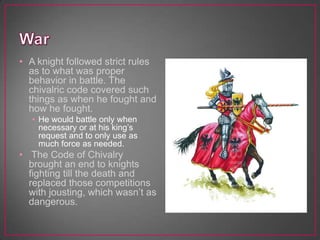

The eyes of all the estates are on the knights, each with their own idea of what honor, prowess, largesse, gentilesse, and courtesy look like.

The weight of chivalric burden comes from society, but does not limit itself to stringent social expectations. The century, the authors, and the audience may change, but the burden remains the same. Regardless of chivalric burden’s impact on the knights in medieval romance, lais, manuals, and biography, the idealized code of chivalry staunchly remains in our twenty-first-century conceptions of masculinity. They develop a system of triage in which oaths are fulfilled by order of perceived importance they alleviate their personal burdens through the creation of brotherhood oaths-effectively reallocating burden amongst themselves, and they often reciprocate unattainable idealism with violence and monstrous behavior. In order to combat the burden of chivalry, most knights, fictional or historical, create a code of their own-one based not upon physical, religious, or social idealism, but instead upon the realities of their experiences. The medieval knight then appears in medieval texts as both the paragon of chivalric perfection and the exempla of perpetual failure. The immediate result of this chivalric burden is the inability of knights to live up to the chivalric code’s exacting physical standards, entropic ecclesiastical expectations, and social obligations. Greene (Creator) Institution The University of North Carolina at Greensboro (UNCG ) Web Site: Advisor Amy VinesĪbstract: This dissertation argues that the chivalric code and resulting “ethos” of chivalry creates a physical, religious, and social burden upon the medieval knights tasked with its application and adherence. Instead, Malory seems content to describe these contradictions as they are without reconciling them, and without explicitly condemning them to hypocrisy.Bearing the weight of honor: knightly navigation of chivalry’s physical, religious, and social burden UNCG Author/Contributor (non-UNCG co-authors, if there are any, appear on document) Corrie W. Besides, even this chivalric ideal is internally contradictory: the ideal of chastity is somewhat at odds with the ideal of defending a lady, for instance, and Malory never explicitly condemns Launcelot’s affair with Guenever-even though it leads to a tragic end-simply because their love is so strong and “pure,” and because Launcelot is such a skilled knight in other aspects. Malory thus shows how deep of a gap there is between the chivalric ideal and the sorry morals of those inhabiting it. For instance, only Galahad, who steers clear of both (mostly because he is so young and is also divinely fated to do so), can attain the Holy Grail, while the other knights are not “pure” enough-that is, they lack the greatest honor and chivalry. Indeed, Malory’s view of the knights and of Arthurian society in general often verges on the cynical, as he shows how various knights succumb to the temptations of lust or of the selfish search for glory. Conversely, Launcelot always grants mercy to a knight that asks for it, underlining his characterization as an honorable knight-in battle, if not in spiritual purity. Sir Gawaine, for instance, refuses to grant mercy to a man who asks for it (thus breaking part of the code) and, as his lover hurls herself forward to protect him, accidentally kills the lady-carrying the shame of this act with him for the rest of his adventures. Chivalry originally referred to the medieval knight’s code of honor but today references a range of usually male behaviors, from courtesy to overprotectiveness. Malory’s collected stories contrast the results of following the code of chivalry with what happens when a knight breaks that code or succumbs to temptation.

He exhibits courage in word and deed, protect the innocent/ defend the weak and innocent, fights with honor, fights for the ideal of king, country, and chivalry and much more. This is a code that is meant to govern the knights’ actions throughout Le morte d’Arthur-however, Malory also takes care to show just how difficult, if not impossible, this code proves for many of the knights, as well as how it can be easily corrupted through circumstance and human folly. Lancelot is a very loyal knight who follows all the codes of chivalry and because of this he earns a position in the round table. Chivalry includes showing mercy, fighting for good, and protecting ladies whenever they may be in harm. Every year, at the Christian feast of Pentecost, the Knights of the Round Table renew their oaths to follow the code of chivalry as proclaimed by King Arthur.


 0 kommentar(er)
0 kommentar(er)
